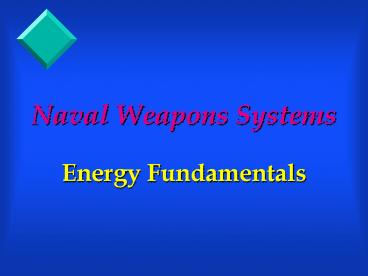Naval Weapons Systems - PowerPoint PPT Presentation
1 / 39
Title:
Naval Weapons Systems
Description:
Maxwell's Theory. Polarization. Interference. Propagation of ... Maxwell's Theory. An accelerating electric field will generate a time-varying magnetic field. ... – PowerPoint PPT presentation
Number of Views:60
Avg rating:3.0/5.0
Title: Naval Weapons Systems
1
Naval Weapons Systems
- Energy Fundamentals
2
Energy FundamentalsOverview
- RADAR
- Electromagnetic (E-M)Wave Characteristics
- Maxwells Theory
- Polarization
- Interference
- Propagation of E-M waves
- Transmission Range factors
3
Energy FundamentalsRADAR
- RAdio Detection And Ranging
- Radar is an electromagnetic wave that acts like
any other electromagnetic wave (i.e. - radio,
light, etc.) - Characteristics of a radio wave assuming a
frequency of 2 Hertz
Cycle
Amplitude
1 second
4
Traveling Wave Characteristics
- Frequency
- Measured
- in Hertz (Hz)
- (Cycles/sec)
- ?(Wavelength) c (Speed of Light)
f (frequency)
5
Traveling Wave Characteristics
- Period
- The time required
- for a full cycle
- Inverse of Frequency
- T1/f
T
6
Traveling Wave Characteristics
- Wavelength
- The distance
- between 2 identical
- points on adjacent
- waves
7
Traveling Wave Characteristics
- Phase
- The angular
- difference where a
- wave begins relative
- to an arbitrary starting
- point
8
Traveling Wave Characteristics
- Velocity
- The speed of light
- Amplitude
- Distance from the
- baseline to the crest of the wave
9
Maxwells Theory
- An accelerating electric field will generate a
time-varying magnetic field. - A time-varying magnetic field will generate a
time-varying electric field. - ...and so on...and so on...and so on...
10
Generation of Electromagnetic Radiation
-
-
-
a
b
c
d
Alternating Current Source
11
Formation of Electric and Magnetic Fields around
an Antenna
E-line
Mag field
e-
e-
e-
Electric field Magnetic Field
Direction of Propagation.
12
Energy Fundamentals
- Part II
- Polarization
- Interference
- Wave Propagation
- Wave Types
13
What is Polarization?
- The direction of polarization of an antenna is
defined as the electric field vector.
14
Interference
- Electromagnetic wave interference can be both
- Constructive
- Destructive
- Interference varies with phase angle
15
Constructive Interference
- Constructive Interference
16
Constructive Interference
- Destructive Interference
17
End of Part 1
- Questions ?
18
Propagation Paths of E-M Waves
- Reflection
- Refraction
- Diffraction
19
...Reflection...
Phase shift 180 degrees. Angle of incidence
Angle of reflected wave.
Reflected Wave
Incident Wave
?R
?I
20
...Refraction...
- Incident wave passes through two transparent
media in which the velocity of light differs... -
Incident wave divides into a reflected wave and a
refracted wave.
Snells Law
21
...Diffraction...
...plane waves traveling in a straight path bend
around a boundary or obstruction.
detected
island
not detected
22
Wave Propagation - relationship between distance
and frequency
- Ground Waves
- Sky Waves
- Space Waves
23
Ground Wave...
- Very low frequencies (VLF)
- Vertical polarization
- Waves travel along earths surface.
- 5-10Khz
- Very long wavelengths - unsuitable for ships
aircraft, except comms - Shore-based installations (HF-DF)
24
Draw on board
25
Sky Wave...
- E-M energy refracts back towards the earths
surface in upper ionosphere layer. - E-M energy then reflects back toward upper layer
again. - Frequencies used up to 550 KHz effectively (LF
and MF region) - Wavelengths still too long for anything but comms
by aircraft and ships.
26
Draw on board
27
Space Wave...
- Above 30 MHz, ionosphere will not refract E-M
waves back toward earth. - Energy tends to travel in straight line.
28
Electromagnetic Spectrum
29
Transmission Range Factors
- Antenna Height
- Target Height
- Ducting
- Losses
- Spreading
- Absorption
- Constructive / Destructive Interference
30
Transmission Losses
- Spreading Energy per unit area proportional to
1/R. - Absorption Molecules of medium absorb some of
the energy as it passes through.
2
31
Communication Systems
32
Basic Comms Path
p. 40 in textbook
33
Transmitter
- Transducers Devices that change energy form
- i.e. acoustic waves to EM waves
- Often boost the power of the signal to increase
distance.
34
Transmission Channel
- Air
- Water
- Wire
- Co-axial
- Fiber Optics
- Beer
35
Transmit/Receive Capability
- Simplex one or the other
- i.e. car radio
- Half-Duplex both, but not at the same time.
- i.e. walkie-talkie or BTB
- Full-Duplex both and at the same time
- i.e. telephone system and most shipboard
communications.
36
Receiver
- Tuner this is what allows you to listen in on a
particular frequency.
37
Modulation
- The process of encoding information on the
Carrier Wave. - A simple Sine wave.
- The Sine wave has 3 independent parameters
- Amplitude
- Frequency
- Phase
38
Noise
- Noise is bad on a communications circuit.
- Two types
- Broadband Noise White Noise
- Narrowband Noise Interference
39
Signal-to-Noise Ratio
- Can be expressed in a pure number
- Signal power / Noise power
- More commonly expressed in Decibels.
- Signal level is on a relative scale compared to
the noise. - The more positive the dB number, the clearer the
signal. - Unless you want to hide it!!!
40
Questions ?
41
Assignment
- Read
- Chapter
- Radar Principles and Systems































